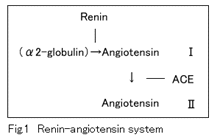|
@EFFECT OF NATTO DIET ON BLOOD PRESSURE
|
Masugi MARUYAMA and Hiroyuki SUMI*
Department of Physiology, Miyazaki Medical College, 5200 Kihara, Kiyotake-cho, Miyazaki-gun, Miyazaki 889-16, JAPAN, *Department of Physiological Chemistry, Science & Industrial Technology, Kurashiki University of Science and Arts, 2640 Turagima-cho-Nishinoura, Kurashiki-shi, Okayama 712, JAPAN
In Japan, it is said that taking Japanese traditional fermented soybean, natto, tends to lower the blood pressure. In spite of the knowledge, there has been almost no evidence which proves the efficacy of natto diet on high blood pressure.
In the present study, we first demonstrated that some components of natto had a lowering effect on blood pressure, by administrating natto extract to human subjects and rats.
We administered a 80% ethanol extract of lyophilize viscous materials of natto. It was reported that the extract contains inhibitors of angiotensin converting enzyme (ACE), which converts angiotensinTto its active form angiotensin U(Fig. 1)1,2).
|

|
Fig.Q
shows systolic blood pressure (SBP) change after administration of 0.5ml of 80% ethanol extract (equivalent to 25 mg of viscous materials) into the peritoneal cavity of Wister rats (400-500 g, male). Average SBP of 6 rats was 166}14 mmHg before administration. After administration of the extract, SBP decreased significantly to 145}24 mmHg in 2 hours (p<0.05), and to 144}27 mmHg in 3 hours (p<0.05).

Fig.R
shows the blood pressure change after oral administration of lyophilized product of 80% ethanol extract to human volunteers who had high blood pressure. Thirty grams of lyophilized extract (equivalent to 200g of natto) was administered per orally for 4 consecutive days. As shown in the figure, in 4 out of 5 volunteers, the SBP as well as diastolicblood pressure (DBP) decreased. The average values decreased from 173.8}20.5 mmHg to 154.8}12.6 in mmHg SBP and 101.0}11.4 mmHg to 91.2}6.6 mmHg in DBP.
For further confirmation of the blood pressure lowering effect of natto, we are going to increase the number of subjects and it is necessary to elucidate the mechanism of the action.
References
1jHayashi W, Nagao K, Tosa S and Yoshioka S: Studies on Natto Science (Natto Kagaku Kaishi, Tokyo), 1: 83-93, 1977
2jHanagata Y, Okamoto A, Koizumi Y and Yanagida T: Basic and Clinical Aspects of Japanese Traditional Food Natto, 1: 89-99, 1994
3jGuidebook of Model MK-1100, p. 1-12, 1994, Muromachi Co. LTD., Osaka
|
|
|
E
|